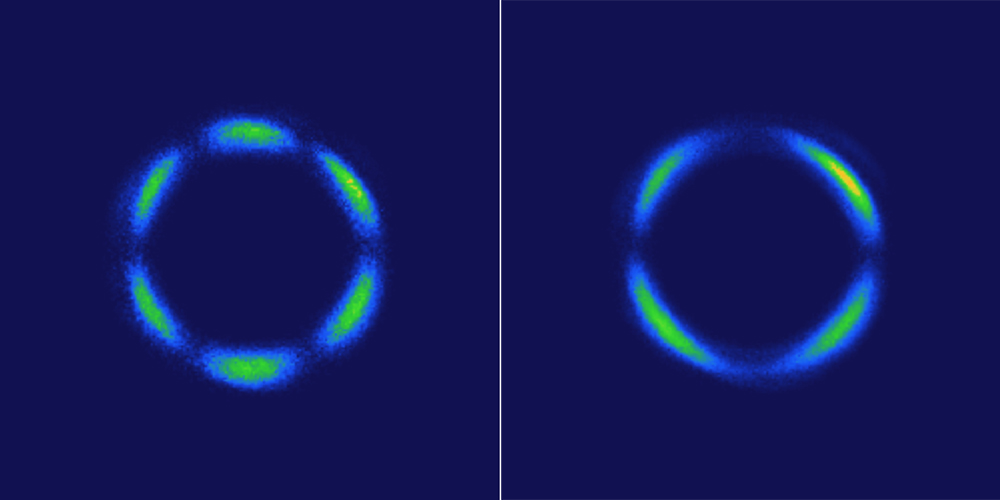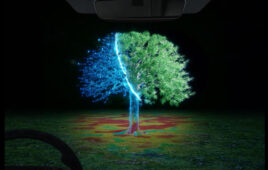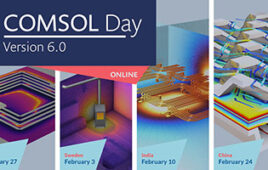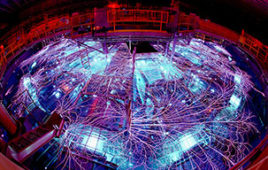
These images show light patterns generated by a rhenium-based crystal using a laser method called optical second-harmonic rotational anisotropy. At left, the pattern comes from the atomic lattice of the crystal. At right, the crystal has become a 3-D quantum liquid crystal, showing a drastic departure from the pattern due to the atomic lattice alone. Credit: Hsieh Lab/ Caltech
A new 3D quantum liquid crystal may pave the way for ultrafast quantum computers in the near future.
Physicists at the Institute for Quantum Information and Matter at Caltech have discovered a new state of matter, which falls somewhere in between a liquid and a solid, and is made of molecules that flow freely as if they were a liquid but are all oriented in the same direction like a solid.
“We have detected the existence of a fundamentally new state of matter that can be regarded as a quantum analog of a liquid crystal,” Caltech assistant professor of physics David Hsieh, principal investigator on the new study, said in a statement. “There are numerous classes of such quantum liquid crystals that can, in principle, exist; therefore, our finding is likely the tip of an iceberg.”
The research team, which included researchers from Oak Ridge National Laboratory and the University of Tennessee, discovered the first 3D quantum liquid crystal where the electrons have different magnetic properties, depending on whether they flow forward or backward on a given axis.
“Running an electrical current through these materials transforms them from nonmagnets into magnets, which is highly unusual,” Hsieh said. “What’s more, in every direction that you can flow current, the magnetic strength and magnetic orientation changes. Physicists say that the electrons ‘break the symmetry’ of the lattice.”
While existing naturally, liquid crystals can be made artificially and are used in the crystal displays of watches, smartphones, televisions and other items that have display screens.
Electrons in quantum liquid crystal move around freely yet have a preferred director of flow similar to how molecules behave in classical liquid crystals.
“Electrons living in this flatland collectively decide to flow preferentially along the x-axis rather than the y-axis even though there’s nothing to distinguish one direction from the other,” John Harter, a postdoctoral scholar in the Hsieh lab and lead author of the study, said in a statement.
Harter discovered the liquid crystal after studying the atomic structure of a metal compound based on rhenium, while firing laser light at a material and light with twice the frequency reflected back out.
The pattern of emitted light contains information about the symmetry of the crystal and the pattern measured from the rhenium-based metal could not be explained by the known atomic structure of the compound.
After learning about the concept of 3D quantum liquid crystals, the researchers concluded that 3D quantum liquid crystals could play a role in spintronics—where the direction that electrons spin may be exploited to create more efficient computer chips.
The 3D quantum liquid crystals could assist with some of the obstacles in building a quantum computer, which seeks to take advantage of the quantum nature of particles to make faster calculations, including those needed decrypt codes. Building a quantum computer is difficult, largely because quantum properties are extremely fragile and can easily be destroyed through interactions with the surrounding environments.
The researchers used topological quantum computing—a technique developed at Caltech—to solve this problem with the assistance of a special superconductor called a topological superconductor.
“In the same way that 2D quantum liquid crystals have been proposed to be a precursor to high-temperature superconductors, 3D quantum liquid crystals could be the precursors to the topological superconductors we’ve been looking for,” Hsieh said.




